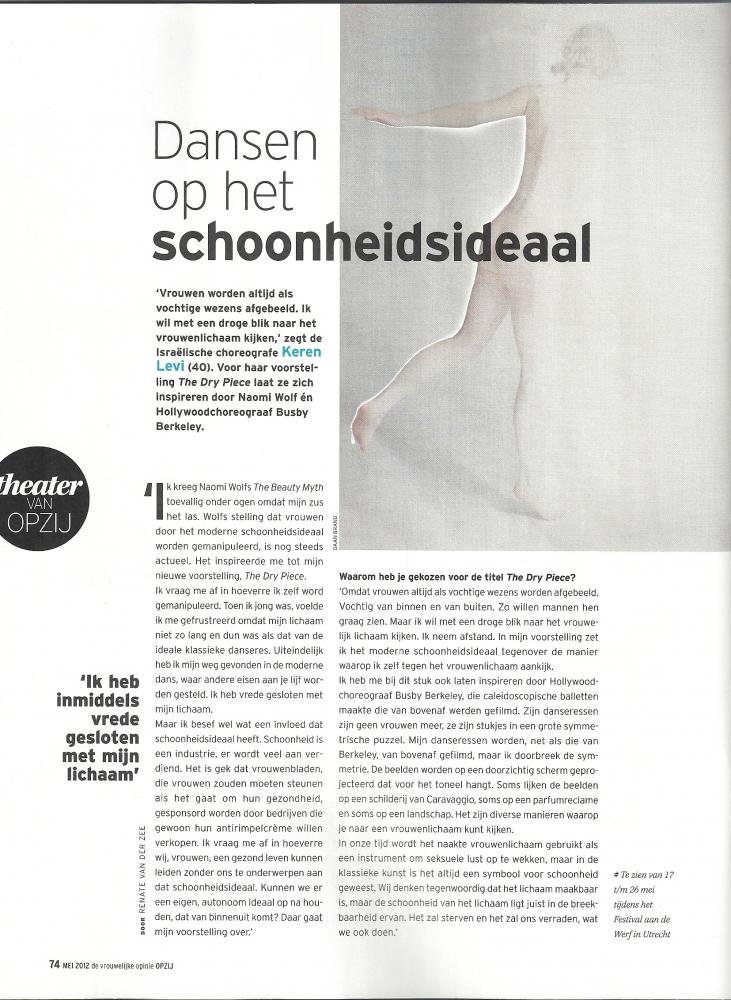THE DRY PIECE
Opzij, Renate Van Der Zee
Dancing (about) Beauty Ideals
Renate Van Der Zee / Opzij, May 2012
‘Women are often depicted as wet creatures. I want to take a dry look at the female body,’ says the Israeli choreographer Keren Levi (40). For her performance The Dry Piece she has taken inspiration from Naomi Wolf as well as Hollywood choreographer Busby Berkely.
‘My eye accidentally fell on Naomi Wolf’s The Beauty Myth because my sister was reading it. Wolf’s thesis that women are manipulated by the modern beauty ideal is still relevant to our times. It has inspired me to create my latest performance, The Dry Piece.
I wonder to what extent I am being manipulated myself. When I was young, I felt frustrated, because my body was not as tall and thin as that of the ideal classical female dancer. Eventually I found my way in contemporary dance, which makes different demands on the body. I have made peace with my body.
But I do realise the impact of the beauty ideal. Beauty is an industry; lots of money is made on it. It is strange that women’s magazines, which should support women where their health is concerned, are sponsored by businesses that basically just want to sell their anti-wrinkle creams. I wonder to what extent we, women, can lead healthy lives without subjecting to this ideal. Can we hold on to our own, autonomous ideal, one that comes from the inside? This is what my performance deals with.’
What made you choose the title ‘ The Dry Piece’?
‘Because women are often depicted as wet creatures. Wet on the inside and wet on the outside. This is the way men like to see them. But I want to take a dry look at the female body. I am distancing myself. In my performance I am juxtaposing the modern beauty ideal with the way I look at the female body myself.
For this piece I have also taken inspiration from the Hollywood choreographer Busby Berkely, who created kaleidoscopic ballets filmed from overhead. His dancers are no longer women; they are pieces in a great big geometric jigsaw. My dancers, like Busby Berkely’s, are filmed from overhead, but I interrupt the symmetry. The images are projected onto a see-through screen that hangs in front of the stage. Some of the images will look like a painting by Carravaggio, some like a perfume commercial, and others like a landscape. These are some of the diverse ways in which the female body can be seen.
In our times, the female body is used as an instrument to incite sexual lust, but in classical art it has been a symbol of beauty. These days we think the body is something we can control, but the beauty of the body lies in its fragile nature. It will die, and it will betray us, no matter what we do.’
Renate Van Der Zee / Opzij, May 2012
‘Women are often depicted as wet creatures. I want to take a dry look at the female body,’ says the Israeli choreographer Keren Levi (40). For her performance The Dry Piece she has taken inspiration from Naomi Wolf as well as Hollywood choreographer Busby Berkely.
‘My eye accidentally fell on Naomi Wolf’s The Beauty Myth because my sister was reading it. Wolf’s thesis that women are manipulated by the modern beauty ideal is still relevant to our times. It has inspired me to create my latest performance, The Dry Piece.
I wonder to what extent I am being manipulated myself. When I was young, I felt frustrated, because my body was not as tall and thin as that of the ideal classical female dancer. Eventually I found my way in contemporary dance, which makes different demands on the body. I have made peace with my body.
But I do realise the impact of the beauty ideal. Beauty is an industry; lots of money is made on it. It is strange that women’s magazines, which should support women where their health is concerned, are sponsored by businesses that basically just want to sell their anti-wrinkle creams. I wonder to what extent we, women, can lead healthy lives without subjecting to this ideal. Can we hold on to our own, autonomous ideal, one that comes from the inside? This is what my performance deals with.’
What made you choose the title ‘ The Dry Piece’?
‘Because women are often depicted as wet creatures. Wet on the inside and wet on the outside. This is the way men like to see them. But I want to take a dry look at the female body. I am distancing myself. In my performance I am juxtaposing the modern beauty ideal with the way I look at the female body myself.
For this piece I have also taken inspiration from the Hollywood choreographer Busby Berkely, who created kaleidoscopic ballets filmed from overhead. His dancers are no longer women; they are pieces in a great big geometric jigsaw. My dancers, like Busby Berkely’s, are filmed from overhead, but I interrupt the symmetry. The images are projected onto a see-through screen that hangs in front of the stage. Some of the images will look like a painting by Carravaggio, some like a perfume commercial, and others like a landscape. These are some of the diverse ways in which the female body can be seen.
In our times, the female body is used as an instrument to incite sexual lust, but in classical art it has been a symbol of beauty. These days we think the body is something we can control, but the beauty of the body lies in its fragile nature. It will die, and it will betray us, no matter what we do.’

